Recently, air fresheners
(spray and solid) have been in the news because of findings that they
contain chemicals that have proven harmful (such as causing liver and kidney
cancer in laboratory animals), and which have been shown to cause breathing
difficulties in humans, especially those with compromised lung function.
Both spray type and plug-in type air fresheners have been implicated, as have
regular candles and scented candles (try
100% beeswax candles instead).
DooDoo Voodoo's germ- and odor-killing action, along with its largely natural
and biodegradable ingredients, can help you attain the fresh-smelling home you
desire...without the negatives associated with the air fresheners that have
been in the news lately.
But you're probably not going to want to
treat your home with DooDoo Voodoo every day to keep it smelling fresh and
inviting. (Although we'd sure appreciate it if you did.) To help
you maintain everyday freshness in your air, we've put together this page to
briefly cover a few other devices
and methods we've personally found to be of great additional value. These are:
UPDATE:
We now primarily use hydroxyl radical generators, both freestanding and
mounted in our HVAC systems, not the types of units discussed below.
For freestanding units, we prefer the Sylvan HX-3000
(available
here on Amazon) or the
Titan 1000 (Google
search result here). Mounted in all our HVAC systems are
the REME HALO; we prefer the original unit, not the newer LED unit (learn
more here). We receive no compensation from any of the
companies/links.
Air Purifiers
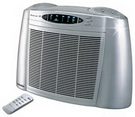 Air purifiers come in a variety of types and with varying degrees of
filtration. We've tried many types and brands at varying prices, and have recently been
very impressed with the 5-step-filtration units from
Neoair.
They do a great job with mold, dust, bacteria, odors, unhealthy gases
(formaldehyde, etc.) and more, so we purchased a dozen of them for our
animal facility and our home. The units are readily available online
from independent dealers or on eBay. (Click
here to go to the results of an eBay search for the
Neoair
68108 units we use.)
There are two popular models, so let me explain the differences.
Air purifiers come in a variety of types and with varying degrees of
filtration. We've tried many types and brands at varying prices, and have recently been
very impressed with the 5-step-filtration units from
Neoair.
They do a great job with mold, dust, bacteria, odors, unhealthy gases
(formaldehyde, etc.) and more, so we purchased a dozen of them for our
animal facility and our home. The units are readily available online
from independent dealers or on eBay. (Click
here to go to the results of an eBay search for the
Neoair
68108 units we use.)
There are two popular models, so let me explain the differences.
The unit that sells
for $199 with free shipping has
5
stages of filtration, including carbon filtration for odor control.
The unit that sells for $299 has only
4
stages of filtration and does NOT have the carbon filtration for odor
control, but is touted as having a stronger HEPA filter than the $199 unit.
The $299 unit is also touted as being able to cover more square feet than
the less expensive unit. Because we care mostly about odor control, we
went with the $199 units and have generally been happy with them, though we
did have one unit's motor go out. Replacement filter sets (recommended
to be changed once a year, but we do it more often) are $45 each with free
shipping.
The 5-stage units
used to only be available through natural-health pioneer
Dr.
Julian Whitaker, which is a great endorsement of their
effectiveness, since he's so well respected in the medical field. Now,
however, you can purchase the 5-stage units from a variety of sources
online. You can view a multi-page PDF about the Dr. Whitaker 5-stage
units by
clicking
here. (The PDF will be helpful to you even if you don't
buy the Dr. Whitaker units.) The Neoair
units were given a very high rating by
this site.
Here's a graphic
that shows the 5 steps of filtration used by the Neoair units we have so
many of. By clicking
here you can visit the page where they
explain the 5 stages via text, pictures and a short video:
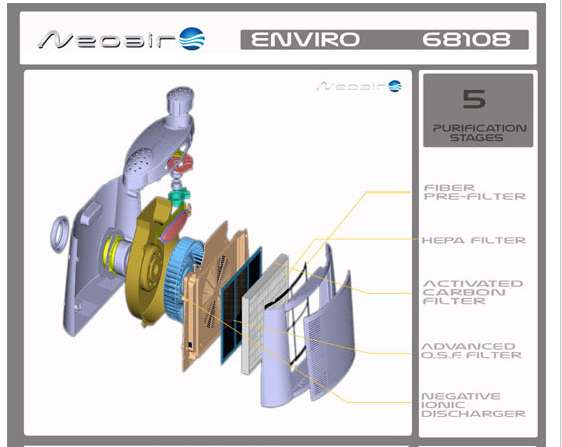
Having said that, and while I
can't vouch for these machines myself, I found a company which claims its
Multi-Tech S3500 units outperform other top brands (including the machine
ranked #1 by Consumer Reports), but at a lower price. I've read about
these units and they seem to offer everything the Neoair units do, but at a
significant savings. There are highly positive user comments on the
site. Visit
http://www.surroundair.com/ionic-air-purifier.htm
to learn more. If you buy one, fire me an
e-mail to let me know how they work.
Ionizers
 Ionizers, too, come
in a variety of styles and technology. Some units generate ozone, which
can be an effective air cleansing methodology, but which can irritate some
people, causing breathing problems, headaches, nausea, lung damage (some say) and more. Other units only generate ions, which attach themselves to
particles in the air, thus making the particles fall to the floor. (The Neoair unit mentioned above is certified not to generate ozone, and does
feature ion generation as one of its 5 stages.) We have had good success
using ionizers from Ecoquest, which recently had financial difficulties and
has become
Vollara. We have specifically had
good luck with the Ecoquest Breeze units, of which we own half a dozen or so
(shown). Older models gave us repair issues, but we've had great luck
with the Breezes. Ecoquest/Vollara units are also available through distributors throughout the USA and
beyond. Some people, including
this site, give the Ecoquest units poor
marks, so do your homework. (The site also contains seemingly objective
reviews and user comments on all manner of air purifiers. We find it to
be a good resource during the decision-making process.)
Ionizers, too, come
in a variety of styles and technology. Some units generate ozone, which
can be an effective air cleansing methodology, but which can irritate some
people, causing breathing problems, headaches, nausea, lung damage (some say) and more. Other units only generate ions, which attach themselves to
particles in the air, thus making the particles fall to the floor. (The Neoair unit mentioned above is certified not to generate ozone, and does
feature ion generation as one of its 5 stages.) We have had good success
using ionizers from Ecoquest, which recently had financial difficulties and
has become
Vollara. We have specifically had
good luck with the Ecoquest Breeze units, of which we own half a dozen or so
(shown). Older models gave us repair issues, but we've had great luck
with the Breezes. Ecoquest/Vollara units are also available through distributors throughout the USA and
beyond. Some people, including
this site, give the Ecoquest units poor
marks, so do your homework. (The site also contains seemingly objective
reviews and user comments on all manner of air purifiers. We find it to
be a good resource during the decision-making process.)
Used
correctly, ionizers can be an important tool in your battle to keep your air
clean, fresh-smelling and healthy for people and pets, but they may not be
right for all customers, as some people are sensitive to ozone, which can be
detrimental to lung tissue in too-large quantities. We've gotten away from using them, and now only
use the
Neoair 5-stage units. We actually
have a number of Breeze and other Ecoquest units that we'd like to sell, so
please
e-mail us if you're interested in them.
We even have some replacement parts and the original boxes for some of the
units.
New Technology:
The AirRestore Unit
In 2014, we were introduced to a new type of air naturalization technology
called AirRestore. It was invented by the man responsible for other
industry-changing air purification technologies of the past, but the science
behind the AirRestore unit is way better. The little gizmos are barely
bigger than a couple smartphones put together, but we have found them to be
highly effective in our home and in our rescue facility. We were so
impressed that we signed on to be dealers for them. If you want to
learn more, visit our
Freshen Your Air page or our
Naturalizer page.
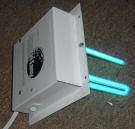 UV Air Treatment
Units
UV Air Treatment
Units
Used correctly, UV light is highly effective at killing mold, mildew,
bacteria, viruses and more as they circulate through your air handling (HVAC)
system. We use a UV unit in our animal rescue facility and it really
helps keep the air healthier and fresher. We paid oodles for our unit
through our HVAC service provider, but you can also purchase a unit and, if
mechanically inclined, install it yourself in 15 minutes or less. Given
the low price, we were skeptical about its quality, but we've been very
happy with this low-cost alternative, the BEUV2, we bought for our home.
It is manufactured by Amilair:
http://www.ezaircleaners.com/.
The replacement bulbs are only $25 each (or less on
eBay).
UV technology is reported to be mandatory for use in government buildings, so
consider implementing it in your facility, too.
Here's some helpful
info, taken from the company's eBay listing, about the BEUV2's technology:
-
•
The lamps are protected by 3
US patents, 1 Canadian patent and 1 European patent.
•
Your HVAC blower blows
microscopic mold spores throughout your home, but the BEUV2's lamps
reduce mold and bacteria before they can recirculate back through your
home.
•
Our lamp uses true
germicidal action; others don't. Our bulbs have UV intensity of 36
and put out 253.7 nm of UVC light, which means they are 99% efficient on
a single pass.
 Air Exchangers
Air Exchangers
Air exchangers trade inside air for outside air, which—at least in most
locales—is a good way to keep your inside air healthier and fresher. We
use an air exchanger in our rescue facility and have found it to be a useful
addition to our air handling system. These units aren't cheap, but can
really do a good job if kept clean and given the benefit of good ducting in
both directions. Here's a link to the results of a Google search:
http://www.google.com/search?sourceid=navclient&aq=t&ie=UTF-8&rlz=1T4GZHZ_enUS239US239&q=air+exchangers.
Here's a link to a site
where you can purchase the same Aprilaire unit shown, which is the one we
use: http://www.alpinehomeair.com/viewproduct.cfm/productID/206/p/Aprilaire__8100_Perfectair_Air_Exchanger
 Air-Quality
Testing
Air-Quality
Testing
In addition to using the technologies discussed above, you might also want
to test your air quality to see if it contains harmful bacteria, viruses and
more. You can purchase do-it-yourself air-quality test kits at
http://www.airoasis.com.
You can also purchase ozone test badges. Scroll to the bottom of the
page to find the test kits and test badges. Shown is the result of an
air test we did in our basement before we implemented the
Neoair air purifier units
mentioned above. Notice the large, white, fuzzy area to the right of
the darker area. Ewwww.
If you're interested in learning
more about indoor air quality and what you can do to improve it, we highly
recommend the book
My House Is Killing Me!,
by Jeffrey
May, available at
Amazon and other booksellers.
Vacuum Cleaners
My wife has accused me of having a vacuum fetish. I'm always on the
lookout for healthier, more effective vacuums. Lately, I've found a
couple I decided to purchase. Let me share what I've learned.
 The first is the
Miele S7280
(right). It is an upright
with lots of solid German engineering and great attributes, but the main feature that sold me is
that it puts out ZERO particles in its exhaust. (After vacuums suck in
air, it gets exhausted from the vacuum. Ever notice an odor when you
turn your vacuum on?) The S7280 is a HEPA vacuum, which contains
nearly 100% of particles down to .3 microns. There are other HEPA
vacuums out there (some of which I own, as my wife will be glad to tell
you), but the Miele is known for being so well sealed that it doesn't shoot
out particles into the air when it's running. The fellow at the vacuum
store pulled out his $2500 particle counter and showed me that other popular
vacuums shoot as many as a few hundred thousand (!) particles into the air
when they run. Not in my house they don't, so I bought a Miele.
The peace of mind is worth the price!
The first is the
Miele S7280
(right). It is an upright
with lots of solid German engineering and great attributes, but the main feature that sold me is
that it puts out ZERO particles in its exhaust. (After vacuums suck in
air, it gets exhausted from the vacuum. Ever notice an odor when you
turn your vacuum on?) The S7280 is a HEPA vacuum, which contains
nearly 100% of particles down to .3 microns. There are other HEPA
vacuums out there (some of which I own, as my wife will be glad to tell
you), but the Miele is known for being so well sealed that it doesn't shoot
out particles into the air when it's running. The fellow at the vacuum
store pulled out his $2500 particle counter and showed me that other popular
vacuums shoot as many as a few hundred thousand (!) particles into the air
when they run. Not in my house they don't, so I bought a Miele.
The peace of mind is worth the price!
Having used the S7280 a lot
lately, I'll say that while it does a very good job, its suction doesn't
seem quite as strong as we thought it would be. In addition, the
swivel nature of the top part of the unit (which makes the unit easier to
navigate around objects) is great, but it injured my wrist. Good
feature, but be careful using it.
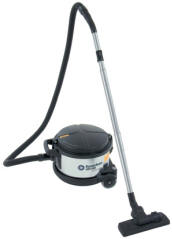 Another vacuum I want to mention
is the
Euroclean GD930
(left), a small HEPA-type
canister vacuum that's used by professional mold and lead remediators. It's
affordable enough to be useful to anyone serious about keeping their place
clean. The bags are affordable; the replacement HEPA filters are less
so, but at least they last a long time. I bought my Euroclean GD930s
(I bought 3)
from a business that sells them on
eBay. It's shown here with the
extensions and one of its included accessories attached, but you don't have
to use it this way. Having spent a lot of personal time with the
Euroclean lately, I must say that I am very impressed. It does a great
job (very strong suction) and feels quite professional. Very well
made.
Another vacuum I want to mention
is the
Euroclean GD930
(left), a small HEPA-type
canister vacuum that's used by professional mold and lead remediators. It's
affordable enough to be useful to anyone serious about keeping their place
clean. The bags are affordable; the replacement HEPA filters are less
so, but at least they last a long time. I bought my Euroclean GD930s
(I bought 3)
from a business that sells them on
eBay. It's shown here with the
extensions and one of its included accessories attached, but you don't have
to use it this way. Having spent a lot of personal time with the
Euroclean lately, I must say that I am very impressed. It does a great
job (very strong suction) and feels quite professional. Very well
made.
# # #
In an effort to keep your
environment as clean, fresh and healthy as possible, we urge you to consider
implementing one or more of these devices, all of which we've found to be
quite beneficial, both in our home and in our animal-rescue facilities and
spay/neuter clinic.
Note that we're not
affiliated with the companies mentioned on this page and that the opinions
expressed are not intended to be a substitute for professional advice,
medical advice and all that other stuff the lawyers say. In
short, we assume no liability for your implementation of any of the devices
mentioned.

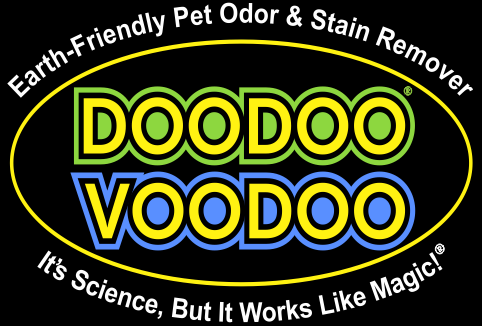






 The first is the
The first is the
